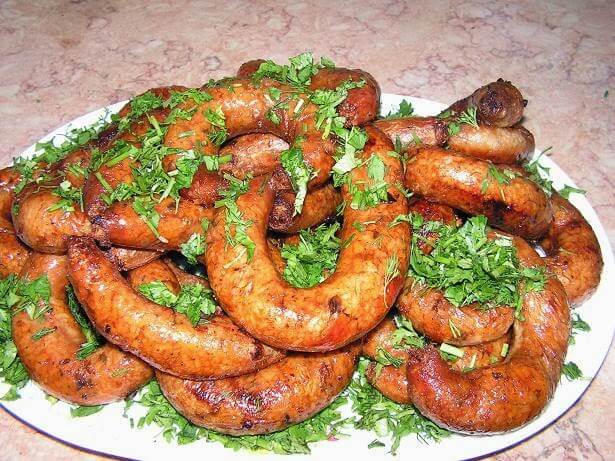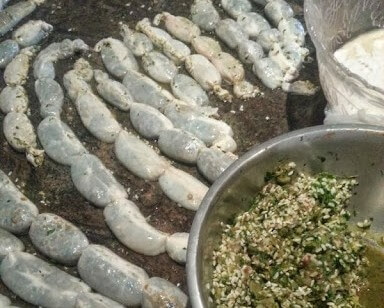
The final product. Image: Shady Alaraby
Arabs are not shy when it comes to food. Nor are they generally big fans of waste.
This combination of qualities leads to a completely bizarre collection of ‘delicacy’ dishes on Arab family menus that ranges from sheep brains and chicken kidneys to cow tongues and the all-notorious Iraqi meal of sheep testicles.
If you’re lucky, you’ll only see this spread of organs on the rarest of occasions.
This means that once you’ve distributed a third of the resulting meat to the poor and a third to friends, relatives or neighbours, you’re left with a third of a sheep or cow or goat for your family.

Stuffing and tying the mombaar.
And when you protest, upon this discovery, your fondness for snags on the barbie is destroyed by news that sausages are actually ground animal fat, meat and fillings cased in the outer lining of the intestine.
Recall, then, the day that your mother tricked you into eating fried, white cauliflower-like pieces that were actually fragmented, fried sheep brain.
You can no longer remain in denial; you just ate intestines.
This year, I decided to embrace the weirdness. Odd as it sounds, the Egyptian delicacy of mombaar tastes pretty delicious – and thankfully, it’s the only fishy organ that my family dishes up on Eid.
It takes about a week to prepare mombaar. The intestines soak in vinegar for a day. Next, they’re buried in flour, lemon and other items of cleaning qualities. Then they’re turned inside out and subjected to the cleaning process again.
Once the casing is as clean as Mr Sheen, it is cut into manageable lengths and stuffed with a mixture of rice, herbs and minced meat. The lengths are divided into smaller links with cotton thread and boiled with celery and cardamom.
When serving day comes along, the boiled pieces are fried to a crisp. Voila! It’s almost like looking at stuffed vine leaves.
Except for the part where you discover that they’re not, in fact, vine leaves.
Bon appetit and Eid Mubarak!
